Impact of Victimisation on People and Criminal Justice System
VerifiedAdded on 2023/06/18
|8
|2670
|219
AI Summary
This article discusses the impact of victimisation on people and the criminal justice system. It covers topics such as victimisation in past history, emotional and practical problems common among crime victims, victim-blaming and self-blame, and changes in the criminal justice system to better serve victims.
Contribute Materials
Your contribution can guide someone’s learning journey. Share your
documents today.
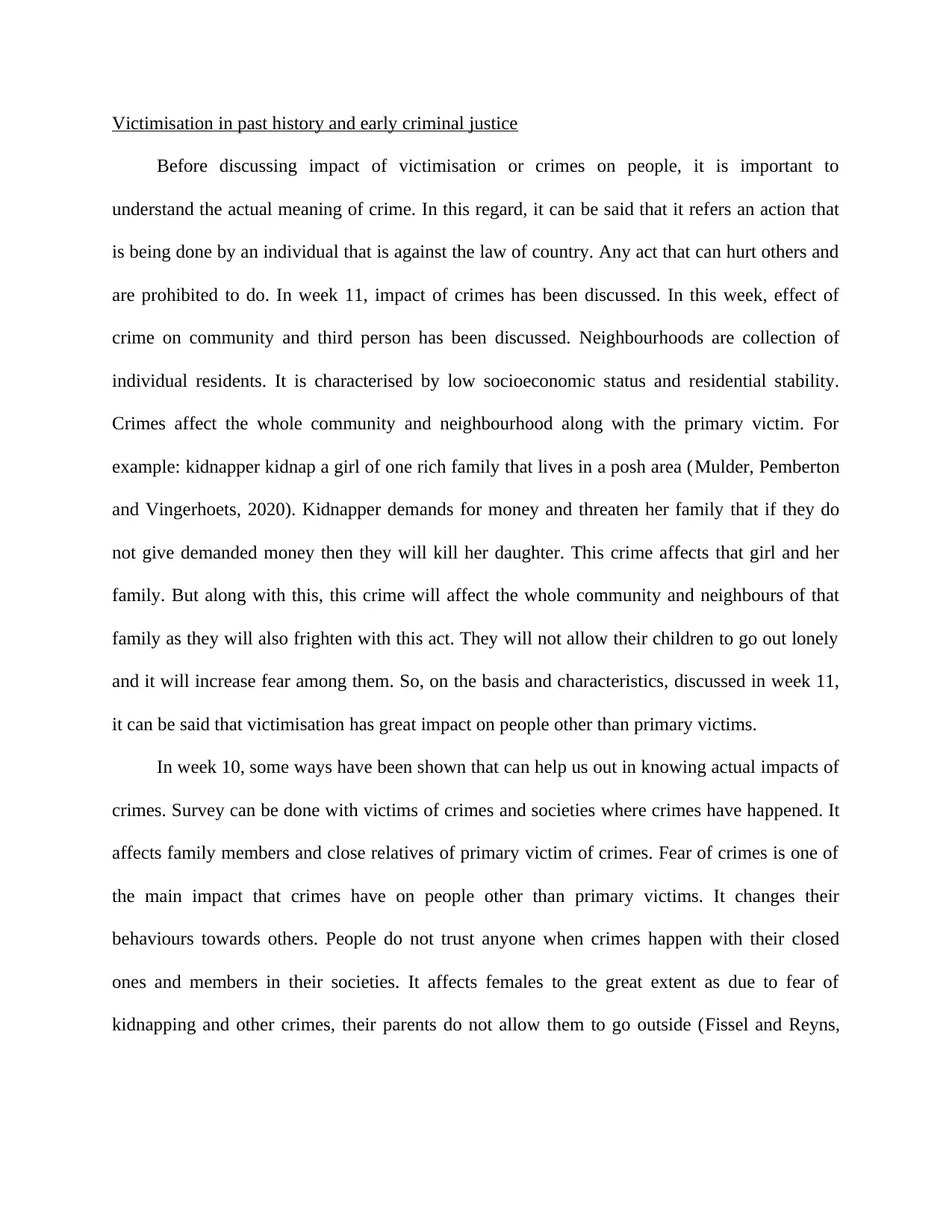
Victimisation in past history and early criminal justice
Before discussing impact of victimisation or crimes on people, it is important to
understand the actual meaning of crime. In this regard, it can be said that it refers an action that
is being done by an individual that is against the law of country. Any act that can hurt others and
are prohibited to do. In week 11, impact of crimes has been discussed. In this week, effect of
crime on community and third person has been discussed. Neighbourhoods are collection of
individual residents. It is characterised by low socioeconomic status and residential stability.
Crimes affect the whole community and neighbourhood along with the primary victim. For
example: kidnapper kidnap a girl of one rich family that lives in a posh area (Mulder, Pemberton
and Vingerhoets, 2020). Kidnapper demands for money and threaten her family that if they do
not give demanded money then they will kill her daughter. This crime affects that girl and her
family. But along with this, this crime will affect the whole community and neighbours of that
family as they will also frighten with this act. They will not allow their children to go out lonely
and it will increase fear among them. So, on the basis and characteristics, discussed in week 11,
it can be said that victimisation has great impact on people other than primary victims.
In week 10, some ways have been shown that can help us out in knowing actual impacts of
crimes. Survey can be done with victims of crimes and societies where crimes have happened. It
affects family members and close relatives of primary victim of crimes. Fear of crimes is one of
the main impact that crimes have on people other than primary victims. It changes their
behaviours towards others. People do not trust anyone when crimes happen with their closed
ones and members in their societies. It affects females to the great extent as due to fear of
kidnapping and other crimes, their parents do not allow them to go outside (Fissel and Reyns,
Before discussing impact of victimisation or crimes on people, it is important to
understand the actual meaning of crime. In this regard, it can be said that it refers an action that
is being done by an individual that is against the law of country. Any act that can hurt others and
are prohibited to do. In week 11, impact of crimes has been discussed. In this week, effect of
crime on community and third person has been discussed. Neighbourhoods are collection of
individual residents. It is characterised by low socioeconomic status and residential stability.
Crimes affect the whole community and neighbourhood along with the primary victim. For
example: kidnapper kidnap a girl of one rich family that lives in a posh area (Mulder, Pemberton
and Vingerhoets, 2020). Kidnapper demands for money and threaten her family that if they do
not give demanded money then they will kill her daughter. This crime affects that girl and her
family. But along with this, this crime will affect the whole community and neighbours of that
family as they will also frighten with this act. They will not allow their children to go out lonely
and it will increase fear among them. So, on the basis and characteristics, discussed in week 11,
it can be said that victimisation has great impact on people other than primary victims.
In week 10, some ways have been shown that can help us out in knowing actual impacts of
crimes. Survey can be done with victims of crimes and societies where crimes have happened. It
affects family members and close relatives of primary victim of crimes. Fear of crimes is one of
the main impact that crimes have on people other than primary victims. It changes their
behaviours towards others. People do not trust anyone when crimes happen with their closed
ones and members in their societies. It affects females to the great extent as due to fear of
kidnapping and other crimes, their parents do not allow them to go outside (Fissel and Reyns,
Secure Best Marks with AI Grader
Need help grading? Try our AI Grader for instant feedback on your assignments.
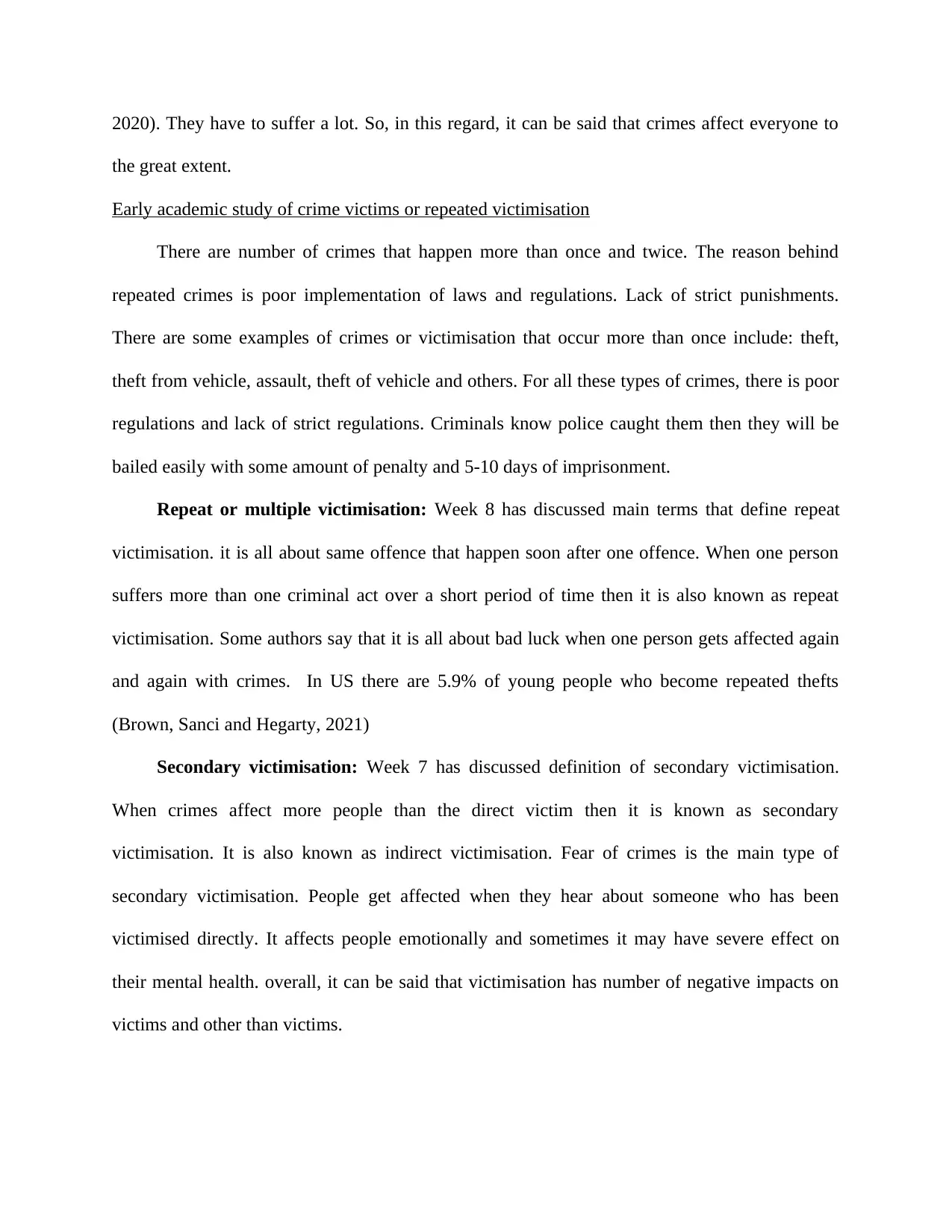
2020). They have to suffer a lot. So, in this regard, it can be said that crimes affect everyone to
the great extent.
Early academic study of crime victims or repeated victimisation
There are number of crimes that happen more than once and twice. The reason behind
repeated crimes is poor implementation of laws and regulations. Lack of strict punishments.
There are some examples of crimes or victimisation that occur more than once include: theft,
theft from vehicle, assault, theft of vehicle and others. For all these types of crimes, there is poor
regulations and lack of strict regulations. Criminals know police caught them then they will be
bailed easily with some amount of penalty and 5-10 days of imprisonment.
Repeat or multiple victimisation: Week 8 has discussed main terms that define repeat
victimisation. it is all about same offence that happen soon after one offence. When one person
suffers more than one criminal act over a short period of time then it is also known as repeat
victimisation. Some authors say that it is all about bad luck when one person gets affected again
and again with crimes. In US there are 5.9% of young people who become repeated thefts
(Brown, Sanci and Hegarty, 2021)
Secondary victimisation: Week 7 has discussed definition of secondary victimisation.
When crimes affect more people than the direct victim then it is known as secondary
victimisation. It is also known as indirect victimisation. Fear of crimes is the main type of
secondary victimisation. People get affected when they hear about someone who has been
victimised directly. It affects people emotionally and sometimes it may have severe effect on
their mental health. overall, it can be said that victimisation has number of negative impacts on
victims and other than victims.
the great extent.
Early academic study of crime victims or repeated victimisation
There are number of crimes that happen more than once and twice. The reason behind
repeated crimes is poor implementation of laws and regulations. Lack of strict punishments.
There are some examples of crimes or victimisation that occur more than once include: theft,
theft from vehicle, assault, theft of vehicle and others. For all these types of crimes, there is poor
regulations and lack of strict regulations. Criminals know police caught them then they will be
bailed easily with some amount of penalty and 5-10 days of imprisonment.
Repeat or multiple victimisation: Week 8 has discussed main terms that define repeat
victimisation. it is all about same offence that happen soon after one offence. When one person
suffers more than one criminal act over a short period of time then it is also known as repeat
victimisation. Some authors say that it is all about bad luck when one person gets affected again
and again with crimes. In US there are 5.9% of young people who become repeated thefts
(Brown, Sanci and Hegarty, 2021)
Secondary victimisation: Week 7 has discussed definition of secondary victimisation.
When crimes affect more people than the direct victim then it is known as secondary
victimisation. It is also known as indirect victimisation. Fear of crimes is the main type of
secondary victimisation. People get affected when they hear about someone who has been
victimised directly. It affects people emotionally and sometimes it may have severe effect on
their mental health. overall, it can be said that victimisation has number of negative impacts on
victims and other than victims.
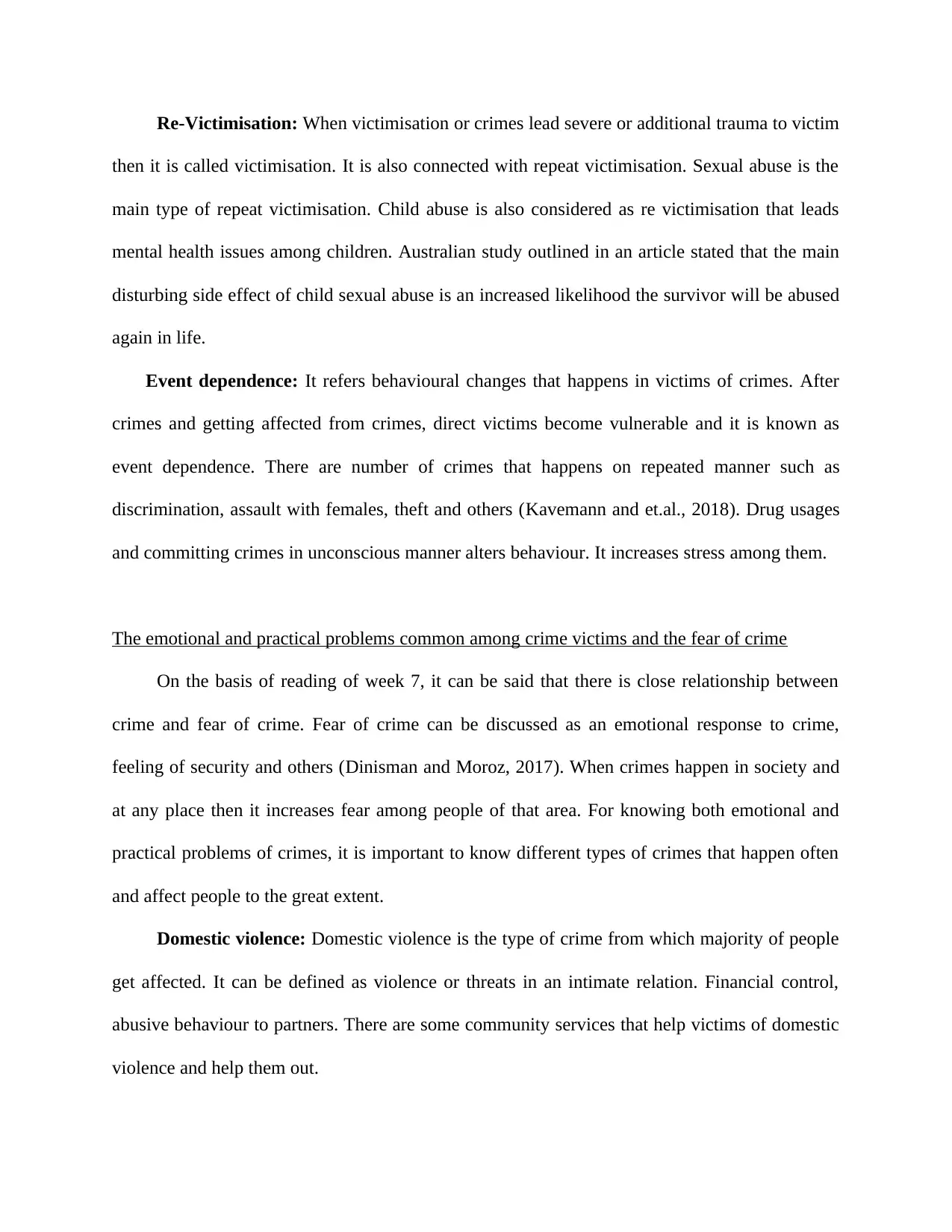
Re-Victimisation: When victimisation or crimes lead severe or additional trauma to victim
then it is called victimisation. It is also connected with repeat victimisation. Sexual abuse is the
main type of repeat victimisation. Child abuse is also considered as re victimisation that leads
mental health issues among children. Australian study outlined in an article stated that the main
disturbing side effect of child sexual abuse is an increased likelihood the survivor will be abused
again in life.
Event dependence: It refers behavioural changes that happens in victims of crimes. After
crimes and getting affected from crimes, direct victims become vulnerable and it is known as
event dependence. There are number of crimes that happens on repeated manner such as
discrimination, assault with females, theft and others (Kavemann and et.al., 2018). Drug usages
and committing crimes in unconscious manner alters behaviour. It increases stress among them.
The emotional and practical problems common among crime victims and the fear of crime
On the basis of reading of week 7, it can be said that there is close relationship between
crime and fear of crime. Fear of crime can be discussed as an emotional response to crime,
feeling of security and others (Dinisman and Moroz, 2017). When crimes happen in society and
at any place then it increases fear among people of that area. For knowing both emotional and
practical problems of crimes, it is important to know different types of crimes that happen often
and affect people to the great extent.
Domestic violence: Domestic violence is the type of crime from which majority of people
get affected. It can be defined as violence or threats in an intimate relation. Financial control,
abusive behaviour to partners. There are some community services that help victims of domestic
violence and help them out.
then it is called victimisation. It is also connected with repeat victimisation. Sexual abuse is the
main type of repeat victimisation. Child abuse is also considered as re victimisation that leads
mental health issues among children. Australian study outlined in an article stated that the main
disturbing side effect of child sexual abuse is an increased likelihood the survivor will be abused
again in life.
Event dependence: It refers behavioural changes that happens in victims of crimes. After
crimes and getting affected from crimes, direct victims become vulnerable and it is known as
event dependence. There are number of crimes that happens on repeated manner such as
discrimination, assault with females, theft and others (Kavemann and et.al., 2018). Drug usages
and committing crimes in unconscious manner alters behaviour. It increases stress among them.
The emotional and practical problems common among crime victims and the fear of crime
On the basis of reading of week 7, it can be said that there is close relationship between
crime and fear of crime. Fear of crime can be discussed as an emotional response to crime,
feeling of security and others (Dinisman and Moroz, 2017). When crimes happen in society and
at any place then it increases fear among people of that area. For knowing both emotional and
practical problems of crimes, it is important to know different types of crimes that happen often
and affect people to the great extent.
Domestic violence: Domestic violence is the type of crime from which majority of people
get affected. It can be defined as violence or threats in an intimate relation. Financial control,
abusive behaviour to partners. There are some community services that help victims of domestic
violence and help them out.
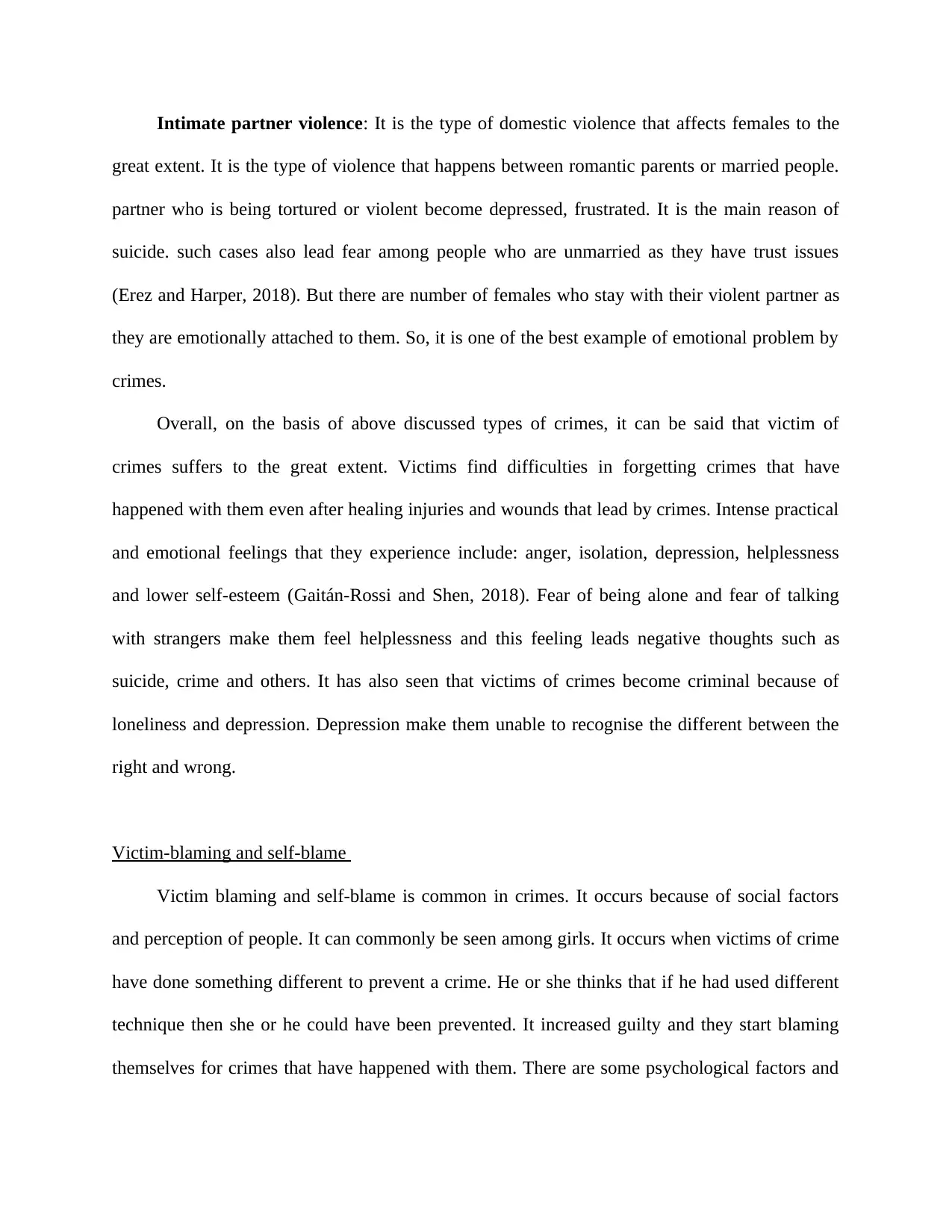
Intimate partner violence: It is the type of domestic violence that affects females to the
great extent. It is the type of violence that happens between romantic parents or married people.
partner who is being tortured or violent become depressed, frustrated. It is the main reason of
suicide. such cases also lead fear among people who are unmarried as they have trust issues
(Erez and Harper, 2018). But there are number of females who stay with their violent partner as
they are emotionally attached to them. So, it is one of the best example of emotional problem by
crimes.
Overall, on the basis of above discussed types of crimes, it can be said that victim of
crimes suffers to the great extent. Victims find difficulties in forgetting crimes that have
happened with them even after healing injuries and wounds that lead by crimes. Intense practical
and emotional feelings that they experience include: anger, isolation, depression, helplessness
and lower self-esteem (Gaitán-Rossi and Shen, 2018). Fear of being alone and fear of talking
with strangers make them feel helplessness and this feeling leads negative thoughts such as
suicide, crime and others. It has also seen that victims of crimes become criminal because of
loneliness and depression. Depression make them unable to recognise the different between the
right and wrong.
Victim-blaming and self-blame
Victim blaming and self-blame is common in crimes. It occurs because of social factors
and perception of people. It can commonly be seen among girls. It occurs when victims of crime
have done something different to prevent a crime. He or she thinks that if he had used different
technique then she or he could have been prevented. It increased guilty and they start blaming
themselves for crimes that have happened with them. There are some psychological factors and
great extent. It is the type of violence that happens between romantic parents or married people.
partner who is being tortured or violent become depressed, frustrated. It is the main reason of
suicide. such cases also lead fear among people who are unmarried as they have trust issues
(Erez and Harper, 2018). But there are number of females who stay with their violent partner as
they are emotionally attached to them. So, it is one of the best example of emotional problem by
crimes.
Overall, on the basis of above discussed types of crimes, it can be said that victim of
crimes suffers to the great extent. Victims find difficulties in forgetting crimes that have
happened with them even after healing injuries and wounds that lead by crimes. Intense practical
and emotional feelings that they experience include: anger, isolation, depression, helplessness
and lower self-esteem (Gaitán-Rossi and Shen, 2018). Fear of being alone and fear of talking
with strangers make them feel helplessness and this feeling leads negative thoughts such as
suicide, crime and others. It has also seen that victims of crimes become criminal because of
loneliness and depression. Depression make them unable to recognise the different between the
right and wrong.
Victim-blaming and self-blame
Victim blaming and self-blame is common in crimes. It occurs because of social factors
and perception of people. It can commonly be seen among girls. It occurs when victims of crime
have done something different to prevent a crime. He or she thinks that if he had used different
technique then she or he could have been prevented. It increased guilty and they start blaming
themselves for crimes that have happened with them. There are some psychological factors and
Paraphrase This Document
Need a fresh take? Get an instant paraphrase of this document with our AI Paraphraser
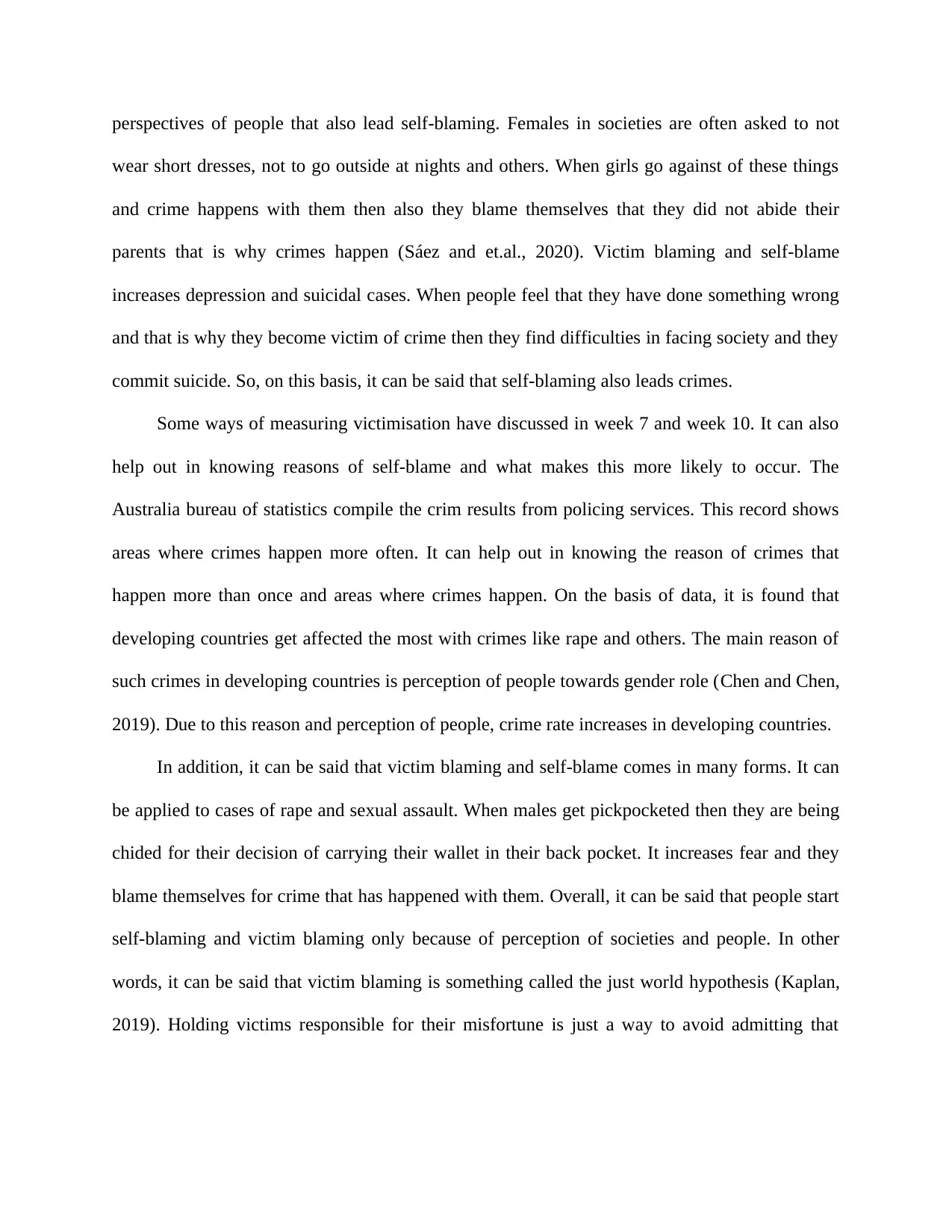
perspectives of people that also lead self-blaming. Females in societies are often asked to not
wear short dresses, not to go outside at nights and others. When girls go against of these things
and crime happens with them then also they blame themselves that they did not abide their
parents that is why crimes happen (Sáez and et.al., 2020). Victim blaming and self-blame
increases depression and suicidal cases. When people feel that they have done something wrong
and that is why they become victim of crime then they find difficulties in facing society and they
commit suicide. So, on this basis, it can be said that self-blaming also leads crimes.
Some ways of measuring victimisation have discussed in week 7 and week 10. It can also
help out in knowing reasons of self-blame and what makes this more likely to occur. The
Australia bureau of statistics compile the crim results from policing services. This record shows
areas where crimes happen more often. It can help out in knowing the reason of crimes that
happen more than once and areas where crimes happen. On the basis of data, it is found that
developing countries get affected the most with crimes like rape and others. The main reason of
such crimes in developing countries is perception of people towards gender role (Chen and Chen,
2019). Due to this reason and perception of people, crime rate increases in developing countries.
In addition, it can be said that victim blaming and self-blame comes in many forms. It can
be applied to cases of rape and sexual assault. When males get pickpocketed then they are being
chided for their decision of carrying their wallet in their back pocket. It increases fear and they
blame themselves for crime that has happened with them. Overall, it can be said that people start
self-blaming and victim blaming only because of perception of societies and people. In other
words, it can be said that victim blaming is something called the just world hypothesis (Kaplan,
2019). Holding victims responsible for their misfortune is just a way to avoid admitting that
wear short dresses, not to go outside at nights and others. When girls go against of these things
and crime happens with them then also they blame themselves that they did not abide their
parents that is why crimes happen (Sáez and et.al., 2020). Victim blaming and self-blame
increases depression and suicidal cases. When people feel that they have done something wrong
and that is why they become victim of crime then they find difficulties in facing society and they
commit suicide. So, on this basis, it can be said that self-blaming also leads crimes.
Some ways of measuring victimisation have discussed in week 7 and week 10. It can also
help out in knowing reasons of self-blame and what makes this more likely to occur. The
Australia bureau of statistics compile the crim results from policing services. This record shows
areas where crimes happen more often. It can help out in knowing the reason of crimes that
happen more than once and areas where crimes happen. On the basis of data, it is found that
developing countries get affected the most with crimes like rape and others. The main reason of
such crimes in developing countries is perception of people towards gender role (Chen and Chen,
2019). Due to this reason and perception of people, crime rate increases in developing countries.
In addition, it can be said that victim blaming and self-blame comes in many forms. It can
be applied to cases of rape and sexual assault. When males get pickpocketed then they are being
chided for their decision of carrying their wallet in their back pocket. It increases fear and they
blame themselves for crime that has happened with them. Overall, it can be said that people start
self-blaming and victim blaming only because of perception of societies and people. In other
words, it can be said that victim blaming is something called the just world hypothesis (Kaplan,
2019). Holding victims responsible for their misfortune is just a way to avoid admitting that
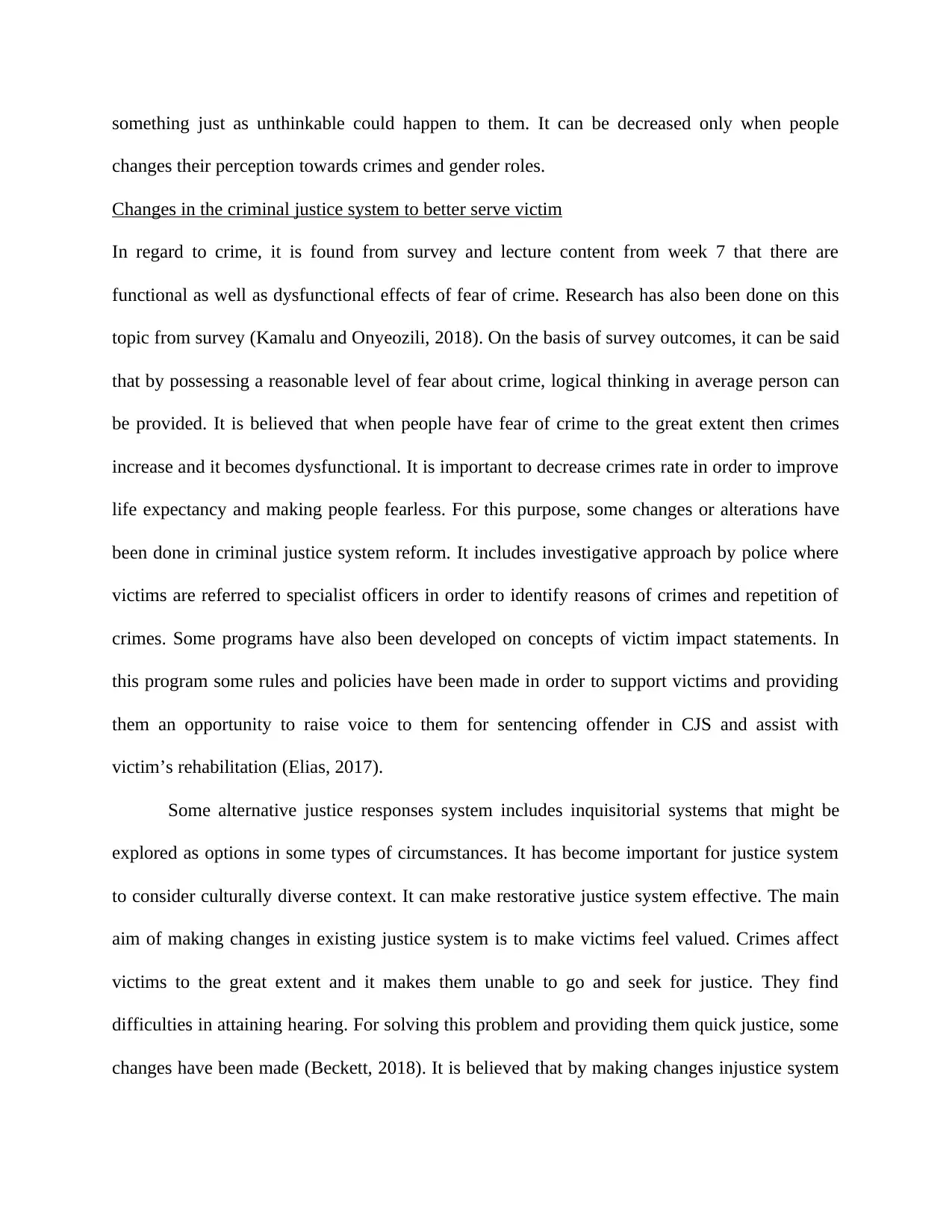
something just as unthinkable could happen to them. It can be decreased only when people
changes their perception towards crimes and gender roles.
Changes in the criminal justice system to better serve victim
In regard to crime, it is found from survey and lecture content from week 7 that there are
functional as well as dysfunctional effects of fear of crime. Research has also been done on this
topic from survey (Kamalu and Onyeozili, 2018). On the basis of survey outcomes, it can be said
that by possessing a reasonable level of fear about crime, logical thinking in average person can
be provided. It is believed that when people have fear of crime to the great extent then crimes
increase and it becomes dysfunctional. It is important to decrease crimes rate in order to improve
life expectancy and making people fearless. For this purpose, some changes or alterations have
been done in criminal justice system reform. It includes investigative approach by police where
victims are referred to specialist officers in order to identify reasons of crimes and repetition of
crimes. Some programs have also been developed on concepts of victim impact statements. In
this program some rules and policies have been made in order to support victims and providing
them an opportunity to raise voice to them for sentencing offender in CJS and assist with
victim’s rehabilitation (Elias, 2017).
Some alternative justice responses system includes inquisitorial systems that might be
explored as options in some types of circumstances. It has become important for justice system
to consider culturally diverse context. It can make restorative justice system effective. The main
aim of making changes in existing justice system is to make victims feel valued. Crimes affect
victims to the great extent and it makes them unable to go and seek for justice. They find
difficulties in attaining hearing. For solving this problem and providing them quick justice, some
changes have been made (Beckett, 2018). It is believed that by making changes injustice system
changes their perception towards crimes and gender roles.
Changes in the criminal justice system to better serve victim
In regard to crime, it is found from survey and lecture content from week 7 that there are
functional as well as dysfunctional effects of fear of crime. Research has also been done on this
topic from survey (Kamalu and Onyeozili, 2018). On the basis of survey outcomes, it can be said
that by possessing a reasonable level of fear about crime, logical thinking in average person can
be provided. It is believed that when people have fear of crime to the great extent then crimes
increase and it becomes dysfunctional. It is important to decrease crimes rate in order to improve
life expectancy and making people fearless. For this purpose, some changes or alterations have
been done in criminal justice system reform. It includes investigative approach by police where
victims are referred to specialist officers in order to identify reasons of crimes and repetition of
crimes. Some programs have also been developed on concepts of victim impact statements. In
this program some rules and policies have been made in order to support victims and providing
them an opportunity to raise voice to them for sentencing offender in CJS and assist with
victim’s rehabilitation (Elias, 2017).
Some alternative justice responses system includes inquisitorial systems that might be
explored as options in some types of circumstances. It has become important for justice system
to consider culturally diverse context. It can make restorative justice system effective. The main
aim of making changes in existing justice system is to make victims feel valued. Crimes affect
victims to the great extent and it makes them unable to go and seek for justice. They find
difficulties in attaining hearing. For solving this problem and providing them quick justice, some
changes have been made (Beckett, 2018). It is believed that by making changes injustice system

and by making it strict, crimes rates can be decreased. In developed countries, there are some
strict rules and punishments are very strict. people think twice before committing crimes. So, on
the basis of this, it can be said that changes in justice system can bring number of positive
changes in societies. It can decrease crimes rate, fear of crimes among people that would
decrease other cases of suicide.
strict rules and punishments are very strict. people think twice before committing crimes. So, on
the basis of this, it can be said that changes in justice system can bring number of positive
changes in societies. It can decrease crimes rate, fear of crimes among people that would
decrease other cases of suicide.
Secure Best Marks with AI Grader
Need help grading? Try our AI Grader for instant feedback on your assignments.
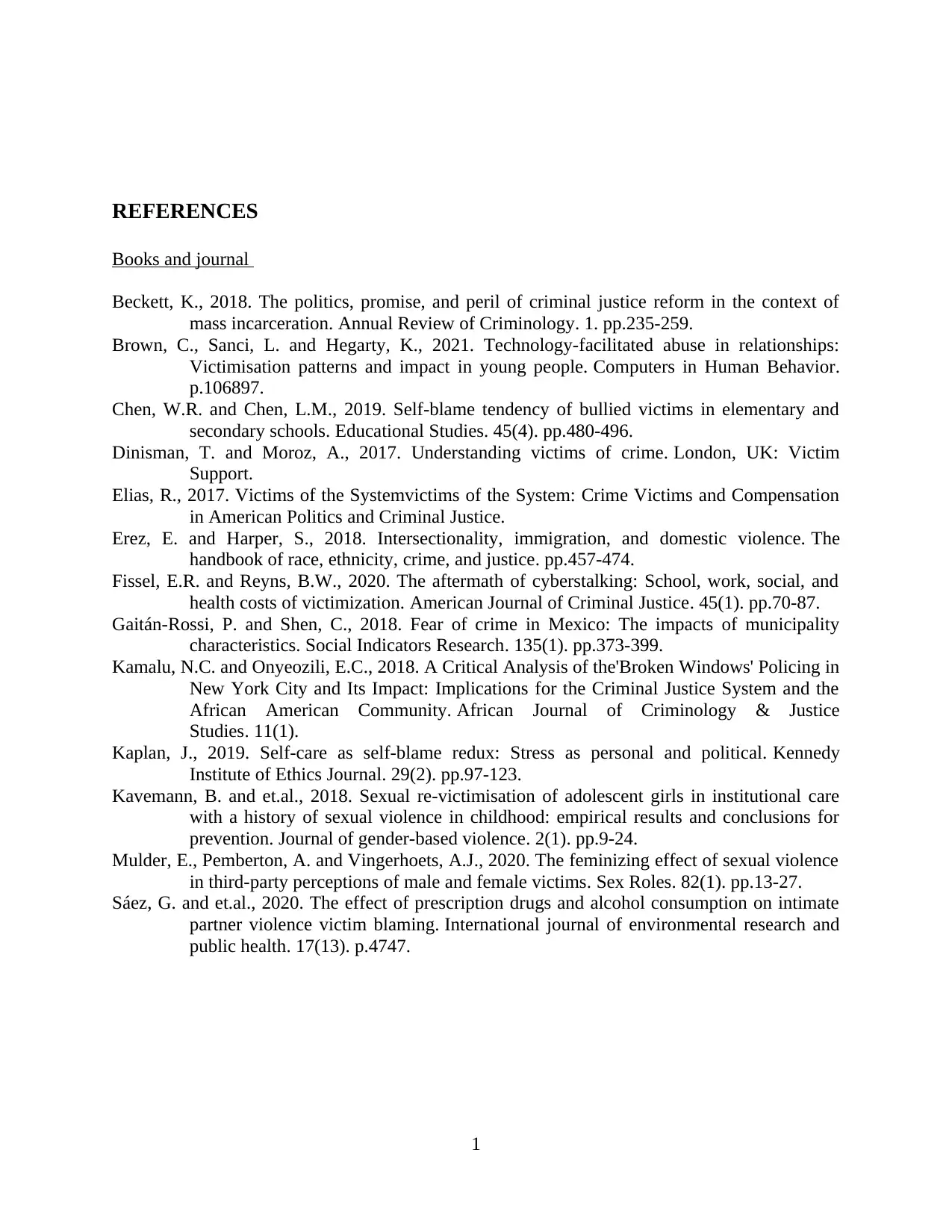
REFERENCES
Books and journal
Beckett, K., 2018. The politics, promise, and peril of criminal justice reform in the context of
mass incarceration. Annual Review of Criminology. 1. pp.235-259.
Brown, C., Sanci, L. and Hegarty, K., 2021. Technology-facilitated abuse in relationships:
Victimisation patterns and impact in young people. Computers in Human Behavior.
p.106897.
Chen, W.R. and Chen, L.M., 2019. Self-blame tendency of bullied victims in elementary and
secondary schools. Educational Studies. 45(4). pp.480-496.
Dinisman, T. and Moroz, A., 2017. Understanding victims of crime. London, UK: Victim
Support.
Elias, R., 2017. Victims of the Systemvictims of the System: Crime Victims and Compensation
in American Politics and Criminal Justice.
Erez, E. and Harper, S., 2018. Intersectionality, immigration, and domestic violence. The
handbook of race, ethnicity, crime, and justice. pp.457-474.
Fissel, E.R. and Reyns, B.W., 2020. The aftermath of cyberstalking: School, work, social, and
health costs of victimization. American Journal of Criminal Justice. 45(1). pp.70-87.
Gaitán-Rossi, P. and Shen, C., 2018. Fear of crime in Mexico: The impacts of municipality
characteristics. Social Indicators Research. 135(1). pp.373-399.
Kamalu, N.C. and Onyeozili, E.C., 2018. A Critical Analysis of the'Broken Windows' Policing in
New York City and Its Impact: Implications for the Criminal Justice System and the
African American Community. African Journal of Criminology & Justice
Studies. 11(1).
Kaplan, J., 2019. Self-care as self-blame redux: Stress as personal and political. Kennedy
Institute of Ethics Journal. 29(2). pp.97-123.
Kavemann, B. and et.al., 2018. Sexual re-victimisation of adolescent girls in institutional care
with a history of sexual violence in childhood: empirical results and conclusions for
prevention. Journal of gender-based violence. 2(1). pp.9-24.
Mulder, E., Pemberton, A. and Vingerhoets, A.J., 2020. The feminizing effect of sexual violence
in third-party perceptions of male and female victims. Sex Roles. 82(1). pp.13-27.
Sáez, G. and et.al., 2020. The effect of prescription drugs and alcohol consumption on intimate
partner violence victim blaming. International journal of environmental research and
public health. 17(13). p.4747.
1
Books and journal
Beckett, K., 2018. The politics, promise, and peril of criminal justice reform in the context of
mass incarceration. Annual Review of Criminology. 1. pp.235-259.
Brown, C., Sanci, L. and Hegarty, K., 2021. Technology-facilitated abuse in relationships:
Victimisation patterns and impact in young people. Computers in Human Behavior.
p.106897.
Chen, W.R. and Chen, L.M., 2019. Self-blame tendency of bullied victims in elementary and
secondary schools. Educational Studies. 45(4). pp.480-496.
Dinisman, T. and Moroz, A., 2017. Understanding victims of crime. London, UK: Victim
Support.
Elias, R., 2017. Victims of the Systemvictims of the System: Crime Victims and Compensation
in American Politics and Criminal Justice.
Erez, E. and Harper, S., 2018. Intersectionality, immigration, and domestic violence. The
handbook of race, ethnicity, crime, and justice. pp.457-474.
Fissel, E.R. and Reyns, B.W., 2020. The aftermath of cyberstalking: School, work, social, and
health costs of victimization. American Journal of Criminal Justice. 45(1). pp.70-87.
Gaitán-Rossi, P. and Shen, C., 2018. Fear of crime in Mexico: The impacts of municipality
characteristics. Social Indicators Research. 135(1). pp.373-399.
Kamalu, N.C. and Onyeozili, E.C., 2018. A Critical Analysis of the'Broken Windows' Policing in
New York City and Its Impact: Implications for the Criminal Justice System and the
African American Community. African Journal of Criminology & Justice
Studies. 11(1).
Kaplan, J., 2019. Self-care as self-blame redux: Stress as personal and political. Kennedy
Institute of Ethics Journal. 29(2). pp.97-123.
Kavemann, B. and et.al., 2018. Sexual re-victimisation of adolescent girls in institutional care
with a history of sexual violence in childhood: empirical results and conclusions for
prevention. Journal of gender-based violence. 2(1). pp.9-24.
Mulder, E., Pemberton, A. and Vingerhoets, A.J., 2020. The feminizing effect of sexual violence
in third-party perceptions of male and female victims. Sex Roles. 82(1). pp.13-27.
Sáez, G. and et.al., 2020. The effect of prescription drugs and alcohol consumption on intimate
partner violence victim blaming. International journal of environmental research and
public health. 17(13). p.4747.
1
1 out of 8
![[object Object]](/_next/static/media/star-bottom.7253800d.svg)
